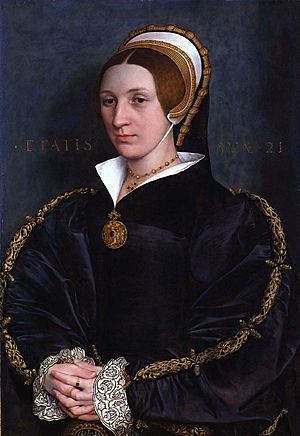French hood facts for kids
The French hood was a popular type of headgear (a fancy hat or covering for the head) worn by women in Western Europe during the 1500s. It looked different from other head coverings of the time, like the "English" or gable hood. The French hood was round, while the English hood was more angular. It was worn over a soft cap called a coif and had a black veil at the back that covered all the hair. Unlike some other styles, the French hood showed off the front part of a woman's hair.
History of the French Hood
The idea for the French hood might have come from portraits of Anne of Brittany in the early 1500s. Many people think of Anne Boleyn when they hear about the French hood. However, it was likely brought to the English court by Mary Tudor, Queen of France. She is shown wearing one in a wedding picture from around 1516.
At that time, most English women wore the gable hood. So, the French hood did not become very popular in England until the 1530s and 1540s. Most pictures from this time show women who worked for one of Henry VIII's wives. This suggests it was mainly a fashion for people at court.
In September 1537, Lady Lisle was a noblewoman whose letters were saved. She asked a merchant for "many hats, such as the ladies wear in France." She noted that "now the ladies here follow the French fashion." Even with its growing popularity, Queen Jane Seymour did not want her ladies to wear the French hood. John Husee told Lady Lisle that her daughter, who served the Queen, had to wear a "bonnet and frontlet of velvet." He felt it "became her nothing so well as the French hood."
In the early 1540s, King Henry VIII passed a sumptuary law. This law limited who could wear "any Frenche hood or bonnet of velvett with any habiliment, paste, or egg [edge] of gold, pearl, or stone." Only the wives of men who owned at least one horse were allowed to wear them. As the 1500s went on, the French hood became smaller and more curved. It was worn further back on the head.
The lists of jewels of Mary, Queen of Scots include several jeweled "billaments." These were worn at the front of a hood. They were called bordure, which is a French word.
How the French Hood Was Made
The French hood was made of several parts. Since no original French hoods still exist, we don't know all the exact details. However, here are the parts we know about:
- Coif – This was a soft cap made of linen. It was tied under the chin or held with pins. From the early 1500s, it was almost always white. Before 1520, some early French hoods had red coifs.
- Crepine – This was a pleated or gathered head covering. It was made from fine linen or silk. Sometimes, it was worn without a coif. It might have been the start of the pleated frill seen at the edge of the coif. The crepine might also have been a bag-like part at the back of early French hoods, worn without a veil.
- Paste – This part was worn over the coif or crepine. Sometimes, more than one in a different color was worn. Its name might come from the paste used to make it stiff. Or it might come from the French word 'passé', meaning "border." This describes the look of a border with a different color on the French hood.
- Veil – This was the main "hood" part, and it was almost always black. It could be made from wool, or silk velvet or satin. It hung straight down and completely covered the hair at the back.
- Billaments – These were decorative borders. They were sometimes called "upper" and "lower" billaments. They formed the fancy edge along the top of the hood and the front edge of the coif or paste. Records show velvet and satin were used to make billaments. This suggests they were the base for goldwork, jewels, and pearls.
- Cornet/Bongrace/Shadow – This was like a visor that shaded the wearer's eyes. Later in the century, the veil of the hood was sometimes flipped up and pinned to shade the eyes. This was also called a "bongrace" or "shadow." It protected the face from the sun.
Some people think the French hood had a stiff, sticking-out crescent shape. But statues from that time show it lay flat on the wearer's head.
Gallery
See also
 In Spanish: Tocado francés para niños
In Spanish: Tocado francés para niños
- 1500–1550 in fashion
- 1550–1600 in fashion
- Kokoshnik








